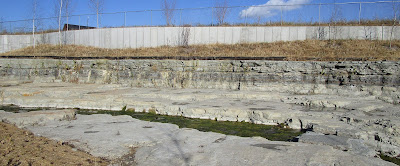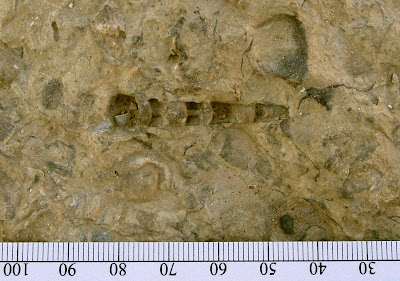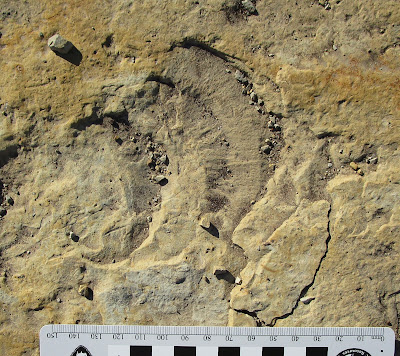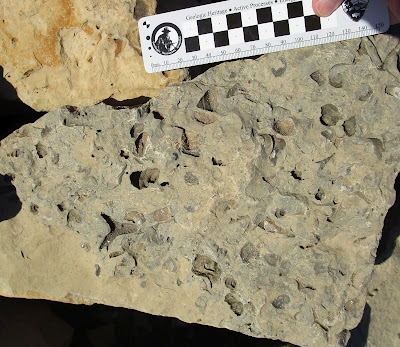So I went back to Uŋčí Makhá Park last weekend and spent a couple of hours
taking photos of fossils, because it makes such an ideal place to see the
upper Platteville fauna. After all, a winter of freezes and thaws may not leave these new exposures
looking as nice as they do now. Here's a quick guide to what can be seen
there. (Let's see how many photos I can squeeze into one post, and how many species I can misidentify!)
Determining where you are stratigraphically
First of all, I'd just like to reiterate the stratigraphy. Most of the vertical extent is in the Magnolia Member of the Platteville Formation, with the upper part composed of the Carimona Member of the Decorah Shale. I'm thinking more or less the entire extent of the Carimona is exposed, based on thickness; at any rate the next thing up would be the shaly part of the Decorah, and there isn't a trace of it to be seen. I'm suspicious because the difference is just so darn clear, but at this site there is an unmistakable color change between the two units: the Carimona is the upper blue-gray interval and the Magnolia is the light tan-gray interval below. The Deicke K-bentonite is the lower and thicker of the two bentonite gaps in the Carimona. (Note that the Carimona is sometimes supplemented or replaced by landscaping, but this is pretty obvious.) As you walk from south to north, the "floor" goes up stratigraphically, so it's not all one bedding plane but a gently rising series of planes, until by the exit you're close to the color change.

|
|
The color change is quite evident here. The Deicke K-bentonite is the
cut-in about halfway up the blue-gray Carimona (above the scale bar in
the center of the photo). |

|
|
Here we've gone north, and the floor has risen. The Deicke is still the
seam in the middle of the blue-gray rocks. |
Taxonomy
I've used Volume 3 of the old "Geology of Minnesota" series as a first-order check on genera. Yes, the two parts are from 1895 and 1897, but there is a very convenient table on pages cxi–cxxiii of the second part that includes a good proxy for the Magnolia fauna as the "Vanuxemia bed" column. Furthermore, I assume that the geologists involved, who'd been working the area for years, had seen all of the most abundant forms, and that what I saw would logically be the most abundant forms as well. The only real catch is the nomenclature, which is pretty outdated in areas like brachiopods and cephalopods.*
*In my weaker moments, I have suspected that past invertebrate paleontologists made a policy of transferring species at random to other genera so they would be the only ones who could keep track of the names and thus make themselves indispensable, although I'm not sure to who.
Preservation
This is mostly the Platteville we're talking about, so the fossils are generally dolomitized, often giving them a sparkly look (due to recrystallizing as dolomite rhombs). Exceptions are in the overlying Carimona, which has what looks like regular Decorah shells in a darker-than-usual matrix. The great majority of fossils are either external molds or internal casts (steinkerns), which may or may not be diagnostic to species or even genera. You can, though, almost immediately tell what major group the vast majority of the fossils belong to. Fossils exposed on the bedding planes (i.e., the ground) are generally in dorsal or ventral view. Fossils exposed in the walls are cross-sections. If you see a string of "eyelashes" in a wall, that's a shell bed in cross-section.

|
|
Here we have two merging shell beds (the darker stringers just above
center). There's also a snail steinkern coming out below and some dark
burrows near the bottom. |
Horn corals
The "Vanuxemia bed" has a couple of species of horn corals, a conical
form (Streptelasma breve) and a more elongate form (Lambeophyllum profundum, transferred from Streptelasma) (Winchell and Schuchert 1895a). I saw
several horn corals at the site and I'm pretty sure they're all
L. profundum. Look for the "corduroy acorns" sticking out of the rock.
The tall ribbed brachiopod Hesperorthis tricenaria can be confused for
a horn coral at a glance, but a closer look will usually reveal the much
different overall shape.

|
|
Just right of center is a pretty good Lambeophyllum profundum,
exposed in relief. See also a nice strophomenid brachiopod on the
left. |
Brachiopods
The "Geology of Minnesota" volume identified 15 brachiopod taxa as being observed or possibly observed in the "Vanuxemia bed", most of which can be seen in Winchell and Schuchert (1895b). Four of these are inarticulates, and
I wasn't really seeing those (but to be fair, when you're looking at thousands
upon thousands of roughly similar shells, they kind of run together). There
are also some generally small nut-like forms, and I didn't see any of those,
either. What I saw were lots and lots of generally D-shaped molds and casts,
some strongly arched and some flatter. (They look more circular if the corners of
the shells are not exposed.) These are opposing valves mostly pertaining to
strophomenids, and lest we get into the difficult taxonomy of brachiopods, you're
generally not going to be able to tell the difference between genera and
species when you're dealing with a lot of featureless recrystallized molds and casts. If,
however, you can see the diamond, congratulations! It's
Strophomena filitexta (frequently incurvata of older references).

|
|
Two S. filitexta are visible here, one in the upper left corner
and one near the lower right. |

|
|
How many strophs can you find? |
There is, though, one species that is quite obviously different from the strophs, present as a minor component of the assemblage: Hesperorthis tricenaria. Because the two valves are distinct, you might think you're looking at two different species. Both valves are ribbed, but one valve is overall flat while the other has a roughly triangular profile.
 |
| Spot the ringer among the strophs. (Hint: it's left of center.) |
The Carimona also has brachiopods here, and they're preserved completely differently, looking much more like shaly Decorah.
Bivalves
"Geology of Minnesota" gives us 16 bivalves species to choose from in the "Vanuxemia bed", illustrated in Ulrich (1897). Unsurprisingly the list is led by species of Vanuxemia, which is a chunky rounded thing. (Also, quite honestly, most of the other Magnolia taxa look pretty similar to Vanuxemia, especially when all you have to go on are steinkerns.) I observed a single nice bivalve, included below, and who am I to call it anything but Vanuxemia?
 |
| And here it is, a steinkern sitting in its own mold. |
Nautiloids
Nautiloids are one of the specialties of the Platteville, and I observed several examples at the park. I did not notice any confirmed examples of the big honking nautiloids, although on review of the photos there is one object that looks suspicious (see below with the snails). Instead, most of them were finger-sized, and only a couple were mildly diagnostic. One of them was the mold of a strongly annulated form. If you go back through the 1897 volume, annulated forms were all put in the magnificent wastebasket Orthoceras, of which seven species had been attributed to the "Vanuxemia bed". Today the species have been scattered to the four winds; my completely unjustified guess is this is "Orthoceras" lesueuri, apparently now assigned to Spyroceras. For informal purposes, you could just call it an annulated orthocone, and any Paleozoic invertebrate paleontologist would know what you mean (even if it does sound like something that would break on the Enterprise).
 |
| I really should have brushed it out. |
There was also a curved cast I initially thought was a snail steinkern, but a closer look revealed chamber sutures. This is instead something that in 1897 would have been attributed to Cyrtoceras or Oncoceras, a curved but not truly coiled nautiloid.
 |
| See center stage, surrounded by the inevitable strophs. |
More abundant were examples like the following, which is nice because it also partially exposes the siphuncle inside the nautiloid. Small, partially exposed, undistinguished orthocone molds and casts can be confused with hyoliths if you don't see the interior structure, but try to get a sense of the cross-section before getting excited. If it's not triangular, it's not a hyolith.
 |
| You get chambers and siphuncle in this one. |
Gastropods
While brachiopods may be dominant in sheer numbers, for species richness in the Magnolia you go to the snails. Even with hyoliths, conulariids, scenellids, and monoplacophorans removed, the 1897 list still has more than 50 species in the "Vanuxemia bed", most (but not all) discussed and illustrated in Ulrich and Scofield (1897). At the park the snails came in four major categories: ornate sharply edged screw-like forms (Lophospira); ornate but not sharply-edged forms with ribbing or texturing on the whorls (Trochonema); simple conical whorls (our old friend Clathrospira); and smooth steinkerns representing several species.
 |
| Sharp-edged screw-like snail without strong texturing on the whorls? You're Lophospira. |
 |
| Smoother-edged whorls with texturing? Trochonema. |
 |
| Two steinkerns are visible near the center here. The example on the left is coiled in a flat plane, indicating it's a small Maclurites or something similar. |
Ostracodes
Ostracodes being primarily microscopic, you're not going to see most of them. However, the Platteville is home to the giant ostracode Eoleperditia fabulites, which looks like a smooth bean up to about 1 cm long. I photographed one small bean-shaped fossil at the park by intention. I'm not completely confident it's E. fabulites, as it bows out a bit (just enough to put me in mind of a small Ctenodonta bivalve), but the species is probably present elsewhere here among the background "noise" of the fossils.
 |
| The fossil in question is slightly right of center. If it *isn't* Eoleperditia, the real thing would look very similar. |
Crinoids
Crinoids were not in great abundance in the Magnolia. I saw one poor-quality columnal. If you want to see crinoids, go up to the Carimona instead.
Trace fossils
Both the Magnolia and the Carimona had some burrows at the park. The Carimona examples were particularly striking, being light-colored "noodles" in the darker limestone.
 |
| Big ol' Platteville burrows. |
 |
| Smaller Carimona noodles. |
The park also has landscaping using extremely "fucoidal" gray stones. (I know the word is obsolete, but ain't it fun to say?) I'm tempted to think these are Carimona blocks harvested elsewhere in the old Ford plant grounds, because they're the right color and thickness, but I have no proof. At any rate, you'll know them when you see them.
 |
| Burrows in a block. |
 |
| I wish I knew where these came from! |
Others
Of course, there were things I couldn't identify.
 |
| This one is frustrating because it's fairly large and has a physical form that doesn't correspond well to any of the common fossils. There's a mold and cast component here as well. |
 |
| It's a big recrystallized thing! (Plus some burrows.) |
 |
| Some kind of carapace fragment? Isotelus is known from the Magnolia, and would be about the biggest carapace-bearing thing available. |
I did not observe any obvious bryozoans, hyoliths, or trilobites here in the Magnolia, although they are not unknown elsewhere. They just tend to be inconspicuous, so I would not be surprised if some could be found by getting in really close to the rocks and making a patient search. There are probably more crinoids than the single columnal I saw, too.
Not a fossil
You'll run into patches of these concentric textured things as well. They are not fossils, but were produced during construction. In fact, we've seen them before, and confirmed they aren't fossils.
 |
| When air hammers meet Platteville. |
References
Catalani, J. A. 1987. Biostratigraphy of the Middle and Late Ordovician cephalopods of the Upper Mississippi Valley area. Pages 187–189 in R. E. Sloan, editor. Middle and Late Ordovician lithostratigraphy and biostratigraphy of the Upper Mississippi Valley. Minnesota Geological Survey, St. Paul, Minnesota. Report of Investigations 35.
Clarke, J. M. 1897. The Lower Silurian Cephalopoda of Minnesota. Pages 760–812 in E. Ulrich, W. Scofield, J. Clarke, and N. H. Winchell. The geology of Minnesota. Minnesota Geological and Natural History Survey, Final Report 3(2). Johnson, Smith & Harrison, state printers, Minneapolis, Minnesota.
Winchell, N. H., and C. Schuchert. 1895a. Sponges, graptolites, and corals from the Lower Silurian in Minnesota. Pages 55–95 in L. Lesquereux, C. Schuchert, A. Woodward, E. Ulrich, B. Thomas, and N. H. Winchell. The geology of Minnesota. Minnesota Geological and Natural History Survey, Final Report 3(1). Johnson, Smith & Harrison, state printers, Minneapolis, Minnesota.
Winchell, N. H., and C. Schuchert. 1895b. The Lower Silurian Brachiopoda of Minnesota. Pages 333–474 in L. Lesquereux, C. Schuchert, A. Woodward, E. Ulrich, B. Thomas, and N. H. Winchell. The geology of Minnesota. Minnesota Geological and Natural History Survey, Final Report 3(1). Johnson, Smith & Harrison, state printers, Minneapolis, Minnesota.
Ulrich, E. O. 1897. The Lower Silurian Lamellibranchiata of Minnesota. Pages 475–628 in E. Ulrich, W. Scofield, J. Clarke, and N. H. Winchell. The geology of Minnesota. Minnesota Geological and Natural History Survey, Final Report 3(2). Johnson, Smith & Harrison, state printers, Minneapolis, Minnesota.
Ulrich, E. O., and W. H. Scofield. 1897. The Lower Silurian Gastropoda of Minnesota. Pages 813–1081 in E. Ulrich, W. Scofield, J. Clarke, and N. H. Winchell. The geology of Minnesota. Minnesota Geological and Natural History Survey, Final Report 3(2). Johnson, Smith & Harrison, state printers, Minneapolis, Minnesota.






No comments:
Post a Comment